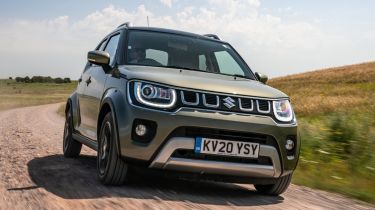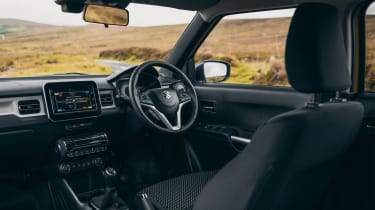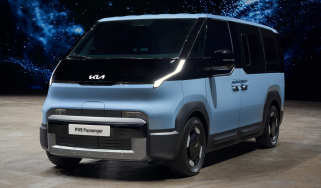Suzuki Ignis review - Interior, design and technology
Loads of kit and stylish design inside and out, yet cabin feels a bit cheap

Key to the Suzuki Ignis’ appeal is its styling. Unlike the boxy old Ignis, today’s model brings a fresh and distinctive approach to small car design, ushering in a crossover-style look that stands out next to rivals.
From the front, the Ignis looks narrow and has a bold bumper and grille design, surrounded by a chrome strip and with U-shaped LED running lights on higher spec models. Side-on, you start to see the crossover influences in the stretched wheelarches and body cladding although, interestingly, you need to choose SZ-T models and above to receive those and roof rails. A Super Black Pearl Metallic roof can also be selected to contrast with one of four optional metallic body-colours or the standard solid Fervent Red.
The rear is where the retro influences lie, with the steeply raked window line and slits in the C-Pillars designed to hark back to Suzuki’s ‘Whizzkid’ city car of the 1970s. The inside is far more conventional, but still more striking than many city car interiors. The two-tone effect for the upper and lower dash brightens things up, as does the body coloured door pulls and centre console plastic. The central screen juts out from the top of the dash, yet the graphics are dated and that lets things down a bit.
Another problem is the materials used. You can tell where Suzuki has made weight savings, particularly with the tinny-feeling doors, but this is forgivable given the price and kerbweight. A lot of the cabin plastics are hard and scratchy, and the seats aren’t very supportive – a number of rivals feel more grown-up inside. It’s all solidly put together, though, and mostly feels built to last.
The Ignis was facelifted in 2020 with exterior styling tweaks that included a new five-bar radiator grille, revised front and rear bumpers and new skid plates, while the cabin now features a new digital instrument cluster with a black and white surround.
Sat-nav, stereo and infotainment
The first UK examples of the Ignis came with a fiddly aftermarket Pioneer infotainment system, but the current SZ-T and SZ5 models now include a 7-inch infotainment display. The SZ5 includes integrated sat-nav, too.
Unfortunately, the screen is not the easiest to use. It often takes a couple of prods to respond to your inputs, while the graphics are low-res and a bit cheap looking. The volume slider on the side of the screen isn’t very user-friendly either.









